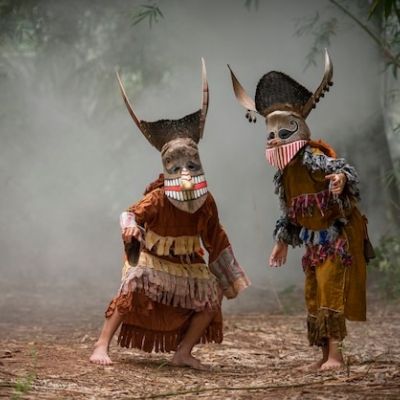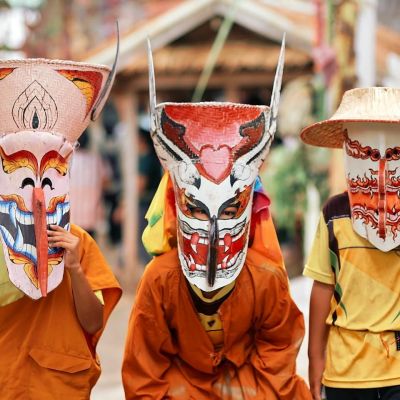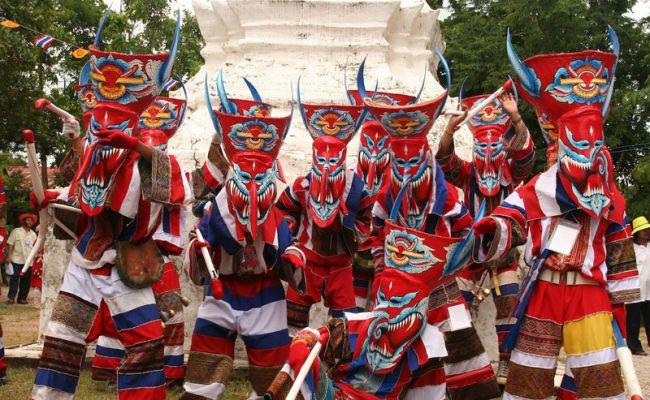Phi Ta Khon [ผีตาโขน] is part of an auspicious and cheerful custom called Boon Luang Festival [บุญหลวง] (the magnificent merit-making festival) in Northeastern Thailand (Isaan). Everyone is free to participate in the Phi Ta Khon parade by just donning a frightening mask and a garment made of waste material.
This practice is celebrated annually in Dan Sai District, Loei Province, during the rainy season, which runs from late June until early July. People dressed as Phi Ta Khon will perform funny dance moves and gestures to brighten the atmosphere and entertain the crowd at the annual celebration, which will take place on the streets of Dan Sai and almost everywhere in Loei, with the main ceremony held at the Wat Phon Chai Temple.
Phi Ta Khon Festival Origin and Significance
Phi Ta Khon Festival, also known as Thailand’s Ghost Festival, has a lengthy history. It is stated that Prince Vessantara (Buddha in his previous incarnation) embarked on a lengthy trip. It was such a lengthy trek that the majority of his fans assumed he had died. Surprisingly, one day, he returned alive and well. His disciples celebrated, and the subsequent festivities were so loud that the dead awoke.

Since then, the festivities have continued. After considerable growth, the Phi Ta Khon festival has become one of the most enjoyable events to attend in Thailand, the Land of Smiles, and an increasingly important component of Bun Pawet, a Buddhist merit-making holiday.
How is Phi Ta Khon Celebrated?
The Boon Luang merit-making event runs for three days. Phi Ta Khon will join the crowds on the first and second days.
Day One: Summoning Phra Upakhut (Phi Ta Khon Day)
Today’s primary event is the summoning of Phra Upakhut. According to mythology, Phra Upakhut was a Buddhist monk who achieved enlightenment and became an arahant. He has the ability to do miracles but prefers to dwell in isolation at the ocean’s navel. King Asoka the Great (268–232 BC) planned a seven-year, seven-month, and seven-day festival to commemorate the construction of 84,000 temples and pagodas. To ensure that his efforts would be safe from bad spirits, King Asoka invited “Phra Upakut” to oversee the auspicious festival. That is when the custom of summoning Phra Upakhut at significant Buddhist rites originated and was eventually embraced by the Thai people.

In order to call Phra Upakhut, the people will first construct the Upakhut Hall. Next, one person will have to stand in the water while another prays on the banks. The one in the water must pick up a rock from the river and ask the other, “Isn’t it Phra Upakhut?” The guy standing on the riverside must respond, “No.” Repeat the whole process three times while changing the rock. On the third try, the guy on the bank will say, “Yes, that’s the real Phra Upakhut.” After the summoning ritual, fireworks and firecrackers will be lit to awaken Phi Ta Khon and invite them to participate in this joyous celebration.
Day two: Prince Vessantara enters the city (Phi Ta Khon procession)
On this day, Prince Vessantara and Phra Upakhut will arrive at the city and temple, respectively. The villagers and Phi Ta Khon will march around the city, lighting fireballs and rockets and dancing to traditional folk music until they arrive at the Wat Phon Chai shrine.
Day 3: Ancestors’ Day.
People will attend religious services and devote virtues and good actions to their departed ancestors. In general, Buddhists will feed monks, listen to Thet Mahachat discourses (tales about the Buddha’s glorious incarnation), and revere holy things in temples.
Masks and Costumes
Phi Ta Khon’s Costumes include a mask and a dress. The mask is composed of a bamboo steamer folded into a hat form with punched holes for the eyes, a long and pointed snout made of wood imitating an elephant’s trunk, and a horn made of dried coconut husks. The mask is then painted uniquely to seem terrifying while still being fun and gorgeous.
Every Phi Ta Khon must carry a wooden sword or weapon. There are two varieties of Phi Ta Khon: Phi Ta Khon Yai and Phi Ta Khon Lek.

Phi Ta Khon Yai (big Phi Ta Khon): It is made of a giant bamboo frame that is twice the size of a person and is covered in fabric or paper. Each year, just two Phi Ta Khon Yais, one male and one female, will be adorned in a fashion that clearly identifies their gender. According to ancient beliefs, the human genitalia represents fertility rather than obscenity. People who play Phi Ta Khon Yais must get permission from a ghost or angel and execute the obligation once a year for a minimum of three years. After the day, Phi Ta Khon Yai’s clothes must be tossed into the Man River, as if to float away unhappiness and ill luck.
Phi Ta Khon Lek (little Phi Ta Khon): It refers to individuals, including young children, teens, and adults, who dress up as ghosts, don the masks indicated above, and participate in the procession. In addition, some individuals may participate in the procession dressed as animals such as horses, elephants, or buffaloes.
When Is Phi Ta Khon Festival
This event is held just once a year, during the end of June and the beginning of July.
Phi Ta Khon festival 2024: Sun, Jul 7, 2024 – Tue, Jul 9, 2024
